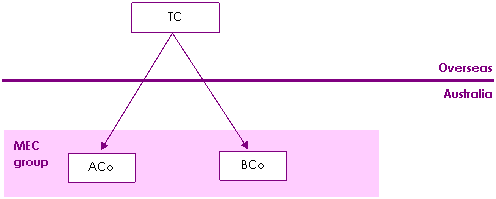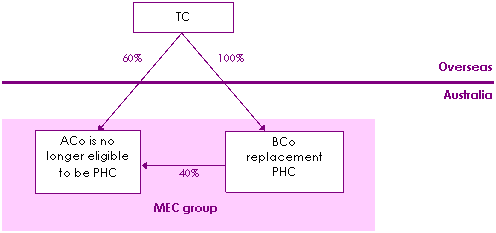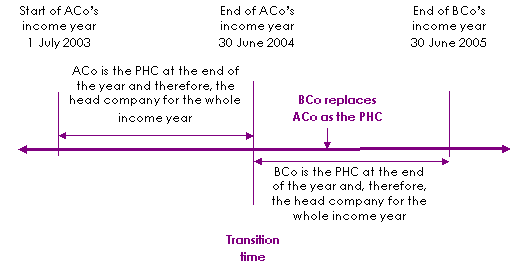Consolidation Reference Manual
You can still refer to the Consolidation reference manual for consolidation information that has not been impacted by changes in the legislation.
C10 MEC groups
C10-2 Worked example
Formation and conversion
C10-2-130 Provisional head company
Description
This example explains:
- •
- how a company qualifies to be a provisional head company (PHC) of a multiple entry consolidated (MEC) group
- •
- how a PHC is appointed
- •
- a PHC's income tax obligations, and
- •
- how a PHC may be replaced, and what happens when it is replaced.
Commentary
Only an eligible tier-1 company can be a PHC of a MEC group. To qualify as the PHC, the eligible tier-1 company must have all its membership interests owned by entities outside the MEC group.
All the eligible tier-1 companies that make a choice in writing to form the MEC group must jointly appoint one of themselves to be the PHC of the group. The choice to consolidate and the appointment of the PHC must be notified to the Commissioner. → subsections 719-50(1), 719-60(1), section 719-76, Income Tax Assessment Act 1997 (ITAA 1997); 'Choice in writing', C7-1-110; 'MEC groups - notices to be given to the Commissioner', C10-1-110
When a MEC group is created from a consolidated group as a result of a special conversion event, the eligible tier-1 companies of the MEC group are taken to have appointed the head company of the former consolidated group as the PHC of the MEC group. → section 719-40, subsection 719-60(2), section 719-78, ITAA 1997; 'Choice on formation, special conversion events and acquisition of new eligible tier-1 companies', C10-2-110 ; 'Group conversions', C10-1-210 )
The provisional head company remains the PHC until a cessation event, which happens if the PHC ceases to exist or ceases to satisfy the qualifying conditions for being a PHC. The Commissioner must be notified if a cessation event happens. → 'MEC groups - notices to be given to the Commissioner', C10-1-110
Income tax obligation of a PHC
The PHC of the group at the end of the income year is taken to be the head company of the MEC group for the whole income year. The head company fulfils the end-of-year income tax obligations of the group, including lodging one income tax return for the group and reconciling PAYG instalments.
During the year, the PHC is also responsible for maintaining the franking account.
A frankable dividend paid by an eligible tier-1 company or a transitional foreign-held subsidiary of the MEC group to an entity that is not a member of the MEC group is taken to have been paid by the PHC for the purposes of applying the franking rules.
The head company is an Australian corporate tax entity for the purposes of applying the conduit foreign income provisions in Subdivision 802-A of the ITAA 1997. Amounts of conduit foreign income received by subsidiary members of the MEC group are treated as being received by the head company. ' 'Treatment of conduit foreign income', C6-2-410 ; section 715-875, ITAA 1997
Replacing a PHC
Once a MEC group is formed, circumstances may change whereby the group no longer has a PHC, such as where a PHC becomes ineligible because it ceases to be a wholly-owned subsidiary of the top company. Such a change will not necessarily affect the ongoing existence of the group. All the eligible tier-1 companies of the group can make a choice in writing to appoint a replacement PHC → 'Choice in writing', C7-1-110 .
A replacement PHC can be appointed provided that:
- •
- it has all its membership interests owned by entities outside the MEC group, and
- •
- it has been a member of the MEC group at all times during the period beginning at either:
- -
- the start of the income year - if the group was in existence at the beginning of the income year in which the cessation event happened, or
- -
- the time the group came into existence - if the group came into existence during the income year in which the cessation event happened,
- and ending when the cessation event happened.
→ subparagraph 719-65(3)(d)(i), ITAA 1997; paragraphs 5.101 to 5.104 of Explanatory Memorandum to the Tax Laws Amendment (2010 Measures No. 1) Bill 2010
The appointment of a new PHC must be notified to the Commissioner.
→ 'MEC groups - notices to be given to the Commissioner', C10-1-110
A replacement PHC must take on the same accounting period as that adopted by the former PHC.
Certain tax attributes (for example, losses and foreign tax credits) of the old head company will be inherited by the new head company under the 'transfer of history' rule. → sections 719-85 and 719-90 of the ITAA 1997; paragraphs 3.117 to 3.129 of Explanatory Memorandum to the New Business Tax System (Consolidation and Other Measures) Bill (No. 1) 2002.
When a new PHC is appointed and the Commissioner is notified within the specified period, the franking account balance (including franking deficit) of the old PHC just before the cessation event happened, is transferred to the new PHC → section 719-430 of the ITAA 1997.
Example 1
Appointment of a provisional head company
TC is the top company. Either ACo or BCo can be the provisional head company as neither has any membership interests owned by another member of the MEC group. In this example, ACo and BCo are both eligible tier-1 companies who make a choice in writing to form a MEC group, jointly appoint ACo to be the PHC and notify the Commissioner within the prescribed time → 'Choice in writing', C7-1-110 .
Figure 1: MEC group

Example 2
Replacement of a provisional head company
Taking the circumstances of Example 1 further: if BCo acquires 40% of ACo from TC, ACo will fail to satisfy the conditions for being a PHC and must notify the Commissioner of this within 28 days → section 719-80, ITAA 1997. ACo and BCo can make a choice in writing to appoint BCo as the new PHC, and must notify the Commissioner of this within 28 days → section 719-79, ITAA 1997; 'Choice in writing', C7-1-110 ; 'MEC groups - notices to be given to the Commissioner', C10-1-110
Figure 2: Replacement of provisional head company

If BCo remains as the PHC at the end of the income year, it will be the head company of the MEC group for the entire income year → section 719-75, ITAA 1997. The time at which BCo replaces ACo as the head company is the start of the income year in which BCo became the PHC, and this is the transition time. Everything that happened to ACo before the transition time is taken to have happened to BCo → sections 719-85 and 719-90, ITAA 1997. This is referred to as the transfer of history rule and it allows BCo to inherit everything that ACo inherited under the entry history rule and the single entity rule → sections 701-5 and 701-1 respectively, ITAA 1997. The purpose of the transfer of history rule is to enable the new head company to calculate its income tax liability, or tax loss, for the income year in which the PHC is replaced, and any later income years.
Figure 3: Timeline of events

References
Income Tax Assessment Act 1936 , Part III, Division 18
Income Tax Assessment Act 1997 , sections 701-1 , 701-5 , 719-60 , 719-65 , 719 -80 ; as amended by New Business Tax System (Consolidation) Act (No. 1) 2002 (No. 68 of 2002), Schedule 1
Explanatory Memorandum to the New Business Tax System (Consolidation) Bill (No. 1) 2002, Chapter 4, paragraphs 4.87-105
Income Tax Assessment Act 1997 , sections 719-85 and 719-90 ; as amended by New Business Tax System (Consolidation and Other Measures) Act (No. 1) 2002 (No. 117 of 2002), Schedule 8
Explanatory Memorandum to the New Business Tax System (Consolidation and Other Measures) Bill (No. 1) 2002, paragraphs 3.117 to 3.129
Income Tax Assessment Act 1997 , sections 719-430 and 719-435 ; as amended by New Business Tax System (Consolidation and Other Measures) Act 2003 (No. 16 of 2003), Schedules 5 , 9 and 24
Explanatory Memorandum to the New Business Tax System (Consolidation and Other Measures) Bill (No. 2), Chapters 8 and 9
Explanatory Memorandum to Tax Laws Amendment ((Loss Recoupment Rules and Other Measures) Bill 2005, paragraphs 5.101 to 5.105
Income Tax Assessment Act 1997 , Subdivision 715-U; as inserted by ( Loss Recoupment Rules and Other Measures) Act 2005 (No 147 of 2005), Schedule 2
Explanatory Memorandum to Tax Laws Amendment (Loss Recoupment Rules and Other Measures) Bill 2005 paragraphs 5.101 - 5.123
Income Tax Assessment Act 1997 , subparagraph 719-65(3)(d)(i) ; as amended by Tax Laws Amendment (2010 Measures No. 1) Act 2010 (No. 56 of 2010), Schedule 5, Part 2
Explanatory Memorandum to Tax Laws Amendment (2010 Measures No. 1) Bill 2010, paragraphs 5.101 - 5.110
Income Tax Assessment Act 1997 , sections 719-76 and 719-78; as inserted by Tax Laws Amendment (2010 Measures No. 1) Act 2010 (No. 56 of 2010), Schedule 5, Part 18
Explanatory Memorandum to Tax Laws Amendment (2010 Measures No. 1) Bill 2010, paragraphs 5.382 - 5.396 and 5.418 to 5.427
History
Revision history
Section C10-2-130 first published (excluding drafts) 2 December 2002 and updated 28 May 2003.
Further revisions are described below.
| Date | Amendment | Reason |
|---|---|---|
| 14.7.04 | Note on changes to consolidation rules, p. 2. | Legislative amendments. |
| 26.10.05 | Changes throughout reflecting changes in the treatment of foreign dividend accounts. | Legislative amendment. |
| 26.6.07 | New text and figure in Example 2. | To clarify meaning of 'transition time'. |
| Extensive changes to Commentary in relation to conduit foreign income. | Legislative amendment. | |
| 6.5.11 | Significant revisions to reflect changes to the choice and notification provisions and for group conversions. | Legislative amendments. |
Current at 6 May 2011
